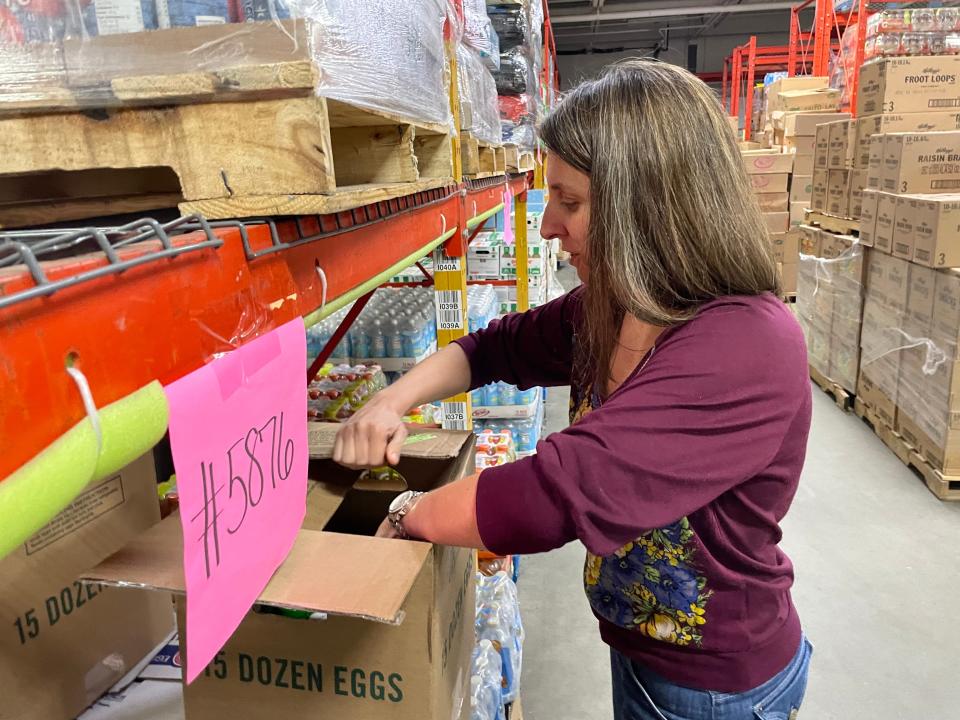SNAP benefits slashed means more demand at local food pantries
While food pantries saw an increase in need due to the pandemic putting people out of work, the need is increasing again due to the end of something meant to help those same people.
In March, the United States Department of Agriculture ended the emergency allotments for Supplemental Nutrition Assistance Program recipients, reverting the benefits to pre-pandemic levels. This means people are receiving less money in benefits, but food is more expensive due to inflation.
Some of the St. Vincent de Paul Place’s clients have seen SNAP reductions from $480 to $88 a month, or from $280 to $45 a month, Pantry Manager Brian Burke said.
“It’s quite the reduction. Sprinkle in the price increase of gas, and you can see it’s difficult right now for even the middle class to make ends meet,” he said.
What that means at the food pantries
At the St. Vincent de Paul Place in Norwich, there was a 51% increase in need this March compared to March 2022. So far this month, 20,000 meals have been provided, compared to 15,000 this time last April, Burke said.
As for The Friends of Assisi Food Pantry in Danielson, they’ve seen an increase in the number of clients, from 15-20 a day, to 35 a day last week, more than they expected. It has also seen other ways the SNAP reduction impacts quality of life. Some clients are now living in their cars, and one returning client lost so much weight from not eating, the staff didn’t recognize him at first, Director Jean Cyr said.
“We feel grateful (to give food to our clients), but we’re also worried for our clients, because they’re a family to us,” she said.

For the Gemma E Moran United Way/Labor Food Center in New London, which operates mobile pantries and helps supply many of the food pantries in eastern Connecticut, there’s been a 25% increase in attendance, especially with people who don’t typically access food, said United Way of Southeastern Connecticut President and CEO Dina Sears-Graves.
“The number is back to normal in terms of what they used to get, the price of food isn’t what it used to be,” she said. ‘It’s putting so much strain on households.”
The USDA is expecting overall food prices to increase 7.5% by the end of the year.
The increasing costs also makes it harder for food banks and pantries to receive donations. Even buying an extra can of food to give away can impact someone’s budget. At Gemma Moran, the food bank still has generous supporters, and is trying to meet the demand the best it can, Sears-Graves said.
The St. Vincent de Paul Place is still receiving food from Gemma Moran, along with Connecticut Foodshare, Midwest Foodbank, local churches and local grocers, Burke said.
“They’ve stepped up their game and we are getting more fruits and veggies and bakery,” he said about the grocery stores.
The local food pantries also are good about sharing excess food with each other, Cyr said.
A minor emergency can be all it takes
With the rush of new households, a lot of the guests may be just barely making it, but become needy when a financial hardship happens, Sears-Graves said.
“People don’t have savings accounts and the assets, so if one thing happens to (them), it sets this snowball effect into play,” she said.
Sears-Graves is hoping there isn’t more demand in coming months, but the food bank is preparing for it anyway. If someone wants to donate, it’s always looking for proteins, pasta ingredients, cereals, and pancake mix.
Even if people can only give a little, it’s still “a tremendous help,” Cyr said.
“We have to take care of each other, because we can’t rely on the government to do it,” she said.
As for what can be done federally, there needs to be more funding put into The Emergency Food Assistance Program from the USDA, Burke said.
The program buys foods and then distributes them to food banks and other entities across the country, who then distribute them further to get them into the hands of the people who need it, according to the benefits.gov website.
Some ways it can be further funded include doubling the program’s funding to $500 million for mandatory purchases, and supply funding for food banks for improving storage infrastructure and distribution costs, Burke said
This article originally appeared on The Bulletin: Food Pantries see more need after SNAP benefit reduction

